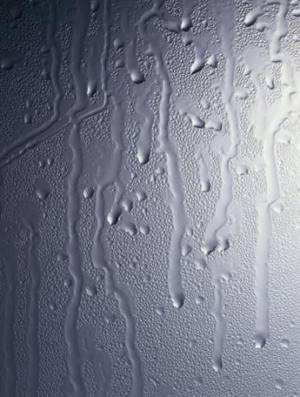Correcting condensation problems in your home is a home improvement project that should be high on your to do
project list. Most condensation remedies are oriented towards creating a change in life style within the home, others are diy home improvement projects that can be undertaken by even a novice home handyman.
Most individuals believe that because they see the condensation on the window itself, that it must be the window or the method of installing the window that has created the problem. This couldn’t be farther from the truth in 99 percent of the cases.

Figure 1 - Condensation on window
Humidity will condense on any surface that is at a lower temperature than the air. If you see condensation forming on windows, there is also condensation forming on walls and other surface areas in your home. Condensation problems that are not corrected can lead to major internal wall and floor damage.
The installation of better quality windows reduces the transfer of cold from the outside of the glass to the inside of the glass. The better quality windows do not stop condensation from occurring within the home, they actual move the condensation to another location within the home.
Causes:
Condensation is created when air is saturated with excess water, which we feel as an increased level of humidity. As the air cannot hold the excess water it disposes of it by condensing it on any convenient surface that has a lower temperature than the air itself.
Why Is The Humidity In My Home High?
The air in our homes picks up water from numerous sources:
- A family of four will add a half pint of water to the air every hour through normal breathing and perspiration.
- Four to five pints of water per day will be added through normal cooking routines.
- Bathing will add a half pint of water on each occurrence.
- Dishwashers exhaust upwards of two pints every time they are used
- One to two pints will be absorbed by the air for each load of washing.
- Clothes dryers can put two to three pints of water into the air on each load.
- Inadequate insulation in crawl spaces allows the water within the soil to penetrate the home.
- Having humidifiers set to add high levels of moisture to the air.
Excess moisture is often a problem in new homes, as the materials used throughout the building must go through a normal “drying” process. The lumber used to construct the home will have levels of moisture throughout the wood that will evaporate into the air. Usually this subsides in less than a year.
In order to reduce condensation from occurring within a home the moisture, which is saturating the air has to be reduced.
Additional information on condensation problems in your home.
